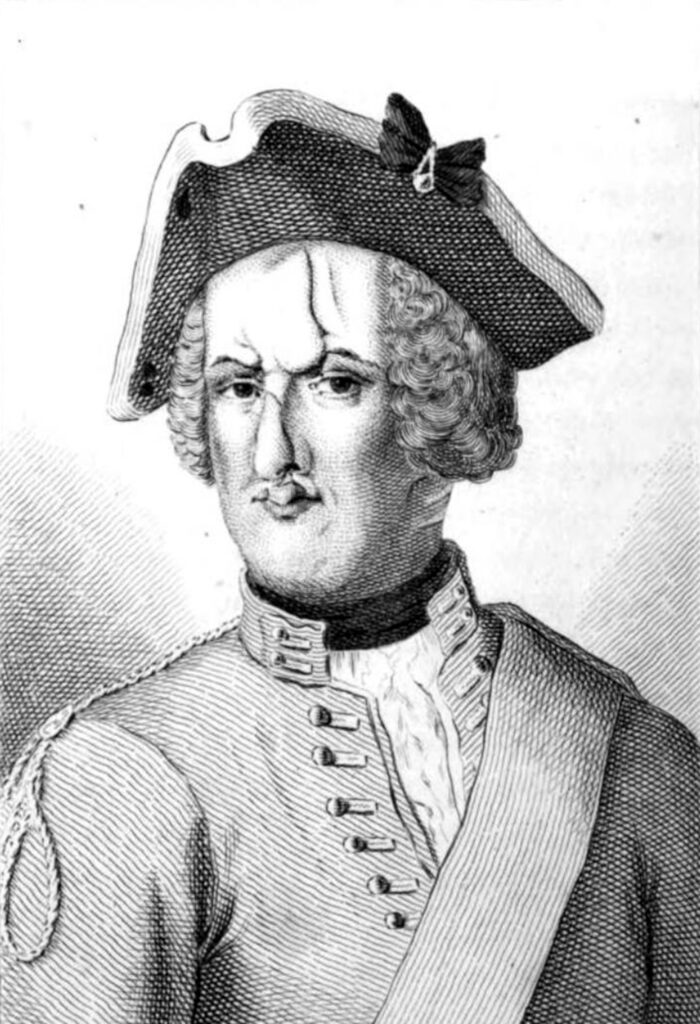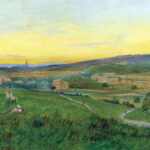27 June 1743: Tom Brown of Kirkleatham’s heroics against the French today at Dettingen (Bavaria) lead his general, George II, to grant him a silver prosthetic nose, immortalised in ballad and portrait

Thomas Brown, after the engraving by Boitard (Anon 1820).
George Young. 1817. A History of Whitby, and Streoneshalh Abbey, Vol. 2. Whitby: Clark and Medd. Get it:
.Excerpt
His father, a blacksmith, planted an oak in their little garden on the day that his son was born, alleging that the plant might come to be a tree when his boy became a man: Tom and his oak grew up together; but it has greatly outlived him; for the days of man are not yet “as the days of a tree.” Tom has long slept in the ground, yet the fame of Tom shall remain when the oak shall have crumbled into dust. He was bred a shoemaker, but, preferring the profession of arms, he enlisted into the Inniskilling Dragoons, whence he was drafted into Bland’s Dragoons and sent to Flanders. It was in the Battle of Dettingen, when he had not been a year in the service, that he acquired his renown. In the early part of the engagement he had two horses killed under him, and lost two fingers of his left hand. Yet when he saw the standard borne off by some gens d’armes, in consequence of a wound received by the cornet, he galloped into the midst of the enemy, shot the soldier who carried off the standard, and having seized it and thrust it between his thigh and the saddle, he gallantly fought his way back through the hostile ranks, about 80 yards, and, though covered with wounds, he bore the prize in triumph to his comrades, who greeted him with three cheers. In this valiant exploit, our hero received eight wounds in his face, head, and neck; three balls went through his hat, and two lodged in his back, from whence they could never be extracted. A pistol shot that grazed his forehead nearly stunned him. The fame of Tom Brown soon spread through the kingdom; his health was drunk with enthusiasm; his achievement was painted on signposts, and prints representing his person and heroic deeds were sold in abundance. He recovered of his wounds, so far as to be able to serve for a short time in the Life Guards: the king would have given him a commission, if he had obtained a suitable education; but it was soon found, that, through the effect of his wounds, he was disqualified for further service; and he retired on a pension of £30 yearly to the town of Yarm, where he died in January 1746.
Comment
Comment
Bob Scotney says that Teesside Archives have found a baptismal record for 25 June 1710. He has also unearthed a marvellous ballad, which contains all the evidence I have that Tom Brown’s proverbially silver prosthetic nose was given him by George II:
King George was pleased with Tommy Brown.
He gave him a pension of thirty crown,
A walking stick with a golden head
And a silver nose to wear instead
(Scotney 2010).
The British Museum has Boitard’s original in better quality than the National Portrait Gallery, but life is too short to consider negotiating rights.
Something to say? Get in touch
Original
This is another hero, raised from the humble walks of life, yet worthy to be ranked with the great and the noble. He was born about the year 1715. A stately oak, that now graces the entrance to Kirkleatham hospital, marks out the spot near which the cottage of his parents stood. His father, who was a blacksmith, planted the oak in their little garden, on the day that his son was born; alleging, that the plant might come to be a tree when his boy became a man: Tom and his oak grew up together; but it has greatly outlived him; for the days of man are not yet “as the days of a tree.” Tom has long slept in the ground; his oak still flourishes in vigour and beauty: yet the fame of Tom shall remain, when the oak shall have crumbled into dust. He was bred a shoe-maker; but, preferring the profession of arms, he enlisted into the Inniskillen dragoons, from whence he was drafted into Bland’s dragoons, and sent to Flanders. It was in the battle of Dettingen, fought June [27], 1743, when he had not been a year in the service, that he acquired his renown. In the early part of the engagement he had two horses killed under him, and lost two fingers of his left hand; yet, when he saw the standard borne off by some gens d’armes, in consequence of a wound received by the cornet, he galloped into the midst of the enemy, shot the soldier who carried off the standard, and having seized it and thrust it between his thigh and the saddle, he gallantly fought his way back through the hostile ranks, about 80 yards, and, though covered with wounds, he bore the prize in triumph to his comrades, who greeted him with three cheers. In this valiant exploit, our hero received 8 wounds in his face, head, and neck; 3 balls went through his hat, and 2 lodged in his back, from whence they could never be extracted. A pistol shot that grazed his forehead nearly stunned him. The fame of Tom Brown soon spread through the kingdom; his health was drunk with enthusiasm; his achievement was painted on sign-posts, and prints representing his person and heroic deeds were sold in abundance. He recovered of his wounds, so far as to be able to serve for a short time in the lifeguards: the king would have given him a commission, if he had obtained a suitable education; but it was soon found, that, through the effect of his wounds, he was disqualified for further service; and he retired on a pension of £30 yearly, to the town of Yarm, where he died in January, 1746. There is still a sign in Yarm that commemorates his valour. His nephew, Mr. Andrew Smith, farmer at Kirkleatham, preserves, as a precious relic, the sword which he used in the action; and has also a scarce portrait of him, in which his face appears marked with scars. He was 5 ft. 11 in. high.
507 words.
Similar
 3 January 1638: On the eve of the civil war, Henry Slingsby witnesses Royalist cavalry exercising near Wetherby on Bramham Moor, scene of the defeat of the Percy Rebellion in 1408
3 January 1638: On the eve of the civil war, Henry Slingsby witnesses Royalist cavalry exercising near Wetherby on Bramham Moor, scene of the defeat of the Percy Rebellion in 1408Search
Donate
Music & books
Place-People-Play: Childcare (and the Kazookestra) on the Headingley/Weetwood borders next to Meanwood Park.
Music from and about Yorkshire by Leeds's Singing Organ-Grinder.



 Bluesky
Bluesky Extwitter
Extwitter